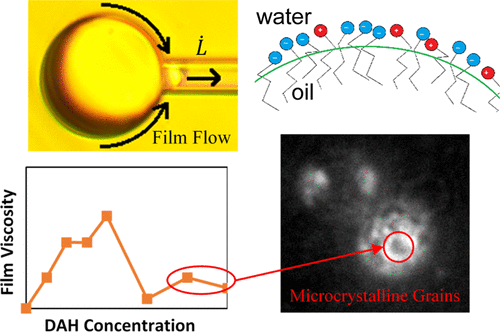Our official English website, www.x-mol.net, welcomes your
feedback! (Note: you will need to create a separate account there.)
Rheological Characterization of Mixed Surfactant Films at Droplet Interfaces via Micropipette Aspiration
Langmuir ( IF 3.7 ) Pub Date : 2018-06-28 00:00:00 , DOI: 10.1021/acs.langmuir.8b00800 Benjamin L. Micklavzina , Kostyantyn Luferov , Marjorie L. Longo
Langmuir ( IF 3.7 ) Pub Date : 2018-06-28 00:00:00 , DOI: 10.1021/acs.langmuir.8b00800 Benjamin L. Micklavzina , Kostyantyn Luferov , Marjorie L. Longo

|
Cationic and anionic surfactant mixtures can form viscous films that dominate the rheology and stability of micrometer-sized droplet suspensions. In this work, we use micropipette aspiration to study the mechanical properties of mixed surfactant surface films of anionic sodium dodecyl sulfate (SDS) and cationic dodecylamine hydrochloride (DAH) on alkane and lipid droplets. For octane droplets, SDS was found to decrease the surface tension until a minimum of 5 ± 1 mJ/m2 was reached after the critical micelle concentration (cmc). The surface viscosity of the droplets was found to be on the order of 10–3 mN s/m at an SDS concentration of 10 mM. An addition of 0.2 mM of DAH was found to increase this viscosity to a peak of 0.24 ± 0.01 mN s/m. Similar to octane, the surface tension of dodecane decreased to a value of 7.7 ± 0.4 mJ/m2 at SDS concentrations above cmc. Unlike with octane, however, the dodecane droplets had a significant surface viscosity of 0.37 ± 0.01 mN s/m when only the 10 mM SDS film was present. An addition of DAH caused a decrease in this viscosity initially, before rising to a peak viscosity of 0.45 ± 0.01 mN s/m at a DAH concentration of 0.15 mM. We speculate that the peaks in viscosities were the result of the completions of a phase change associated with microcrystalline SDS/DAH grains growing in the film at the surface of the droplets. Fluorescence microscopy and visual observations provided further evidence that these films can show rigid microcrystalline-like structure. Further work done with soybean oil in the same conditions and with a lipid film, simulating biological lipid droplets, confirmed that lipid droplets behave rheologically similar to alkanes in the presence of these mixed surfactant and lipid films. These results imply that droplet mechanics may be heavily influenced by the presence of microcrystalline grains in the oil–water systems with complex surfactant mixtures.
中文翻译:

通过微量移液管吸取在液滴界面处的混合表面活性剂膜的流变特性
阳离子和阴离子表面活性剂混合物可形成粘性膜,该粘性膜支配微米级液滴悬浮液的流变性和稳定性。在这项工作中,我们使用微量移液器吸取来研究烷基十二烷基硫酸钠(SDS)和阳离子十二烷基胺盐酸盐(DAH)在烷烃和脂质液滴上的混合表面活性剂表面膜的机械性能。对于辛烷液滴,发现SDS会降低表面张力,直到在临界胶束浓度(cmc)之后达到最低5±1 mJ / m 2为止。发现液滴的表面粘度约为10 –3在10 mM的SDS浓度下为mN s / m。发现添加0.2 mM的DAH可使该粘度增加到0.24±0.01 mN s / m的峰值。类似于辛烷,十二烷的表面张力降低至7.7±0.4 mJ / m 2的值在高于cmc的SDS浓度下。但是,与辛烷不同,当仅存在10 mM SDS膜时,十二烷液滴的表面粘度显着为0.37±0.01 mN s / m。添加DAH最初会导致该粘度降低,然后在0.15 mM的DAH浓度下上升至峰值粘度0.45±0.01 mN s / m。我们推测粘度的峰值是与液滴表面薄膜中生长的微晶SDS / DAH晶粒相关的相变完成的结果。荧光显微镜和视觉观察提供了进一步的证据,这些膜可以显示出刚性的微晶状结构。在相同条件下用豆油和脂膜进行进一步的工作,以模拟生物脂滴,证实在这些混合的表面活性剂和脂质膜的存在下,脂质液滴的流变学行为与烷烃相似。这些结果表明,在具有复杂表面活性剂混合物的油水系统中,微滴的存在可能会严重影响液滴的力学性能。
更新日期:2018-06-28
中文翻译:

通过微量移液管吸取在液滴界面处的混合表面活性剂膜的流变特性
阳离子和阴离子表面活性剂混合物可形成粘性膜,该粘性膜支配微米级液滴悬浮液的流变性和稳定性。在这项工作中,我们使用微量移液器吸取来研究烷基十二烷基硫酸钠(SDS)和阳离子十二烷基胺盐酸盐(DAH)在烷烃和脂质液滴上的混合表面活性剂表面膜的机械性能。对于辛烷液滴,发现SDS会降低表面张力,直到在临界胶束浓度(cmc)之后达到最低5±1 mJ / m 2为止。发现液滴的表面粘度约为10 –3在10 mM的SDS浓度下为mN s / m。发现添加0.2 mM的DAH可使该粘度增加到0.24±0.01 mN s / m的峰值。类似于辛烷,十二烷的表面张力降低至7.7±0.4 mJ / m 2的值在高于cmc的SDS浓度下。但是,与辛烷不同,当仅存在10 mM SDS膜时,十二烷液滴的表面粘度显着为0.37±0.01 mN s / m。添加DAH最初会导致该粘度降低,然后在0.15 mM的DAH浓度下上升至峰值粘度0.45±0.01 mN s / m。我们推测粘度的峰值是与液滴表面薄膜中生长的微晶SDS / DAH晶粒相关的相变完成的结果。荧光显微镜和视觉观察提供了进一步的证据,这些膜可以显示出刚性的微晶状结构。在相同条件下用豆油和脂膜进行进一步的工作,以模拟生物脂滴,证实在这些混合的表面活性剂和脂质膜的存在下,脂质液滴的流变学行为与烷烃相似。这些结果表明,在具有复杂表面活性剂混合物的油水系统中,微滴的存在可能会严重影响液滴的力学性能。











































 京公网安备 11010802027423号
京公网安备 11010802027423号